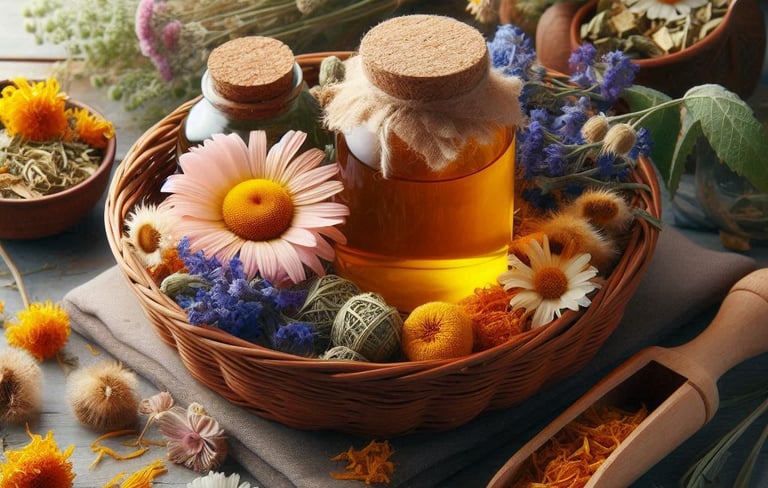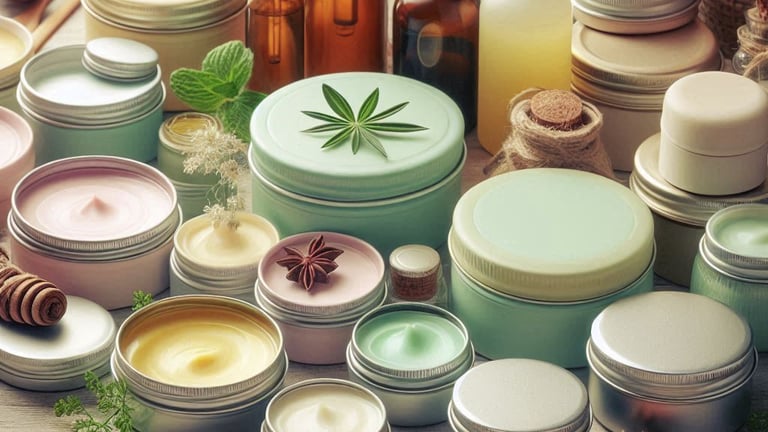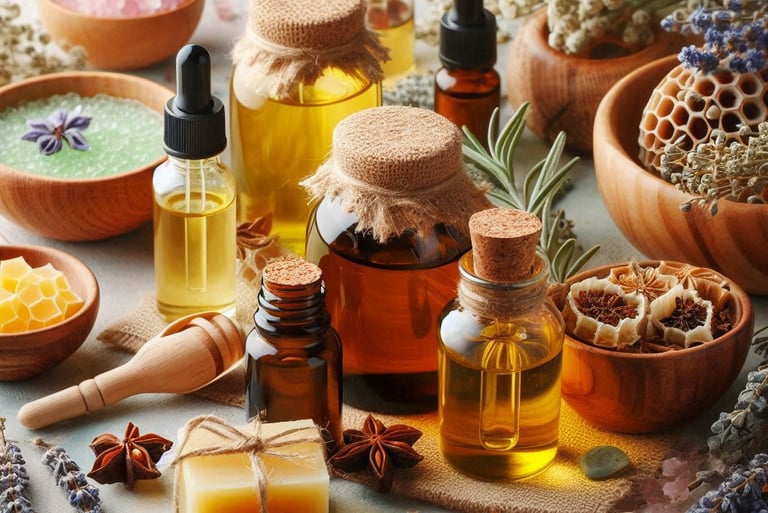How to Make Your Own Herbal Salves at Home: Ingredients and Instructions
Make your own herbal salves at home.
HERBAL WISDOM
Kathrine-Anne Hill
8/19/20249 min read
Introduction to Herbal Salves
Herbal salves have long been treasured for their natural healing properties, providing a gentle and effective remedy for a variety of skin ailments. These ointments are infused with the beneficial properties of herbs, offering relief from conditions such as dry skin, cuts, burns, and insect bites. The use of herbal salves dates back to ancient times, where they were prominently used in traditional medicine for their soothing and restorative qualities.
Creating your own herbal salves at home presents numerous advantages. Firstly, it allows you to have complete control over the ingredients, ensuring that only high-quality, natural components are used, free from potentially harmful additives found in some commercial products. This control also extends to customization; you can tailor the salves to address your specific skin needs and preferences by selecting herbs that cater to your unique requirements. Additionally, making herbal salves at home can be cost-effective. By investing in a few basic supplies, you can produce a larger quantity of high-quality salves at a fraction of the cost of store-bought options.
This blog post will guide you through the entire process of making your own herbal salves. We will start by exploring the essential ingredients needed and the beneficial properties of different herbs you might choose to incorporate. Following this, we will provide a step-by-step guide on the preparation and crafting of the salves, ensuring you have all the information needed to create your own personalized herbal remedies. Whether you are a novice or someone with a keen interest in natural skincare solutions, this post will equip you with the knowledge and skills to successfully make and enjoy the benefits of homemade herbal salves.
Essential Ingredients for Basic Herbal Salves
Creating your own herbal salves at home begins with understanding the essential ingredients involved. The cornerstone of any herbal salve includes carrier oils, beeswax, and essential oils, each playing a crucial role in the formulation's efficacy and consistency.
Carrier Oils: Carrier oils like olive oil or coconut oil form the base of your herbal salve. These oils are chosen for their ability to nourish the skin and act as vehicles for delivering the herbal properties deep into the skin's layers. Olive oil is known for its moisturizing and anti-inflammatory properties, while coconut oil is praised for its antifungal and antibacterial benefits. The ratio for carrier oils in a basic salve recipe is typically 1 cup of carrier oil.
Beeswax: Beeswax is indispensable for providing the salve's solid form and texture. It also adds a protective barrier to the skin, helping to lock in moisture and extend the shelf life of the final product. For a basic recipe, use approximately 1 ounce of beeswax for every cup of carrier oil. Beeswax pellets can be convenient for measuring and melting.
Essential Oils: Essential oils not only impart fragrance but also contribute therapeutic benefits to the salve. For instance, lavender essential oil is known for its calming and healing properties, while tea tree oil is recognized for its antiseptic qualities. The amount of essential oil can vary depending on personal preference and desired strength, but a standard measure is about 20-30 drops of essential oil per cup of carrier oil.
Understanding these foundational ingredients and their roles is pivotal in creating a basic herbal salve. Following this fundamental framework ensures a balanced blend that is both effective and pleasing to use.
Step-by-Step Instructions for Making Herbal Salves
Creating your own herbal salve at home is a fulfilling process that allows you to customize ingredients for specific needs. Here, we provide a detailed guide to help you through each step, from infusing oils with herbs to pouring the final product into containers.
1. Infusing Oils with Herbs: Start by choosing high-quality dried herbs and a light carrier oil such as olive, jojoba, or almond oil. Fill a clean jar halfway with the dried herbs and cover them completely with the oil. Cap the jar securely and place it in a warm, sunny spot for 2-3 weeks, shaking it gently every day. For a quicker method, you can use a slow cooker on the lowest setting for 4-6 hours. Once infused, strain the oil through a fine mesh sieve or cheesecloth, ensuring no herb particles remain.
2. Melting Beeswax: Next, measure your strained herbal oil and pour it into a double boiler. For every cup of infused oil, add approximately one ounce of beeswax pellets. Heat gently until the beeswax is fully melted, stirring occasionally to mix thoroughly. Beeswax provides the salve with its solid form and lends a soothing quality to the salve.
3. Mixing the Ingredients: Once the beeswax is melted and evenly combined with the infused oil, remove the mixture from heat. At this stage, you can also add a few drops of essential oils for added benefits, such as lavender for calming effects or tea tree for antiseptic properties. Stir well to integrate the essential oils into the mixture.
4. Pouring into Containers: While the mixture is still warm, pour it into clean, dry containers such as tins or glass jars. Allow the salve to cool and solidify completely, which typically takes a few hours. Cap the containers tightly and label them with the ingredients and date made.
Tips for a Smooth Texture and Consistency: Achieving the perfect salve consistency may require some adjustment. If your salve is too soft, melt it down and add more beeswax. Conversely, if it is too hard, melt and add more infused oil. Ensuring the proper ratio of oil to beeswax is key to a smooth, spreadable texture.
Unique Ingredients to Enhance Your Herbal Salves
When crafting your own herbal salves, incorporating unique ingredients can significantly enhance their healing properties and effectiveness. One such ingredient is comfrey, known for its remarkable ability to aid in the healing of wounds, bruises, and sprains. Comfrey contains allantoin, a compound that promotes cell regeneration and accelerates the healing process. A recommended quantity for comfrey-infused oil or comfrey root powder in your salve is between 10 to 15 grams per cup of carrier oil.
Calendula is another powerful addition to herbal salves. Renowned for its anti-inflammatory and antimicrobial properties, calendula is particularly beneficial for treating skin issues such as eczema, rashes, and minor burns. It helps to reduce redness and swelling, promoting quicker recovery. Infused calendula oil can be made by steeping dried calendula petals in a carrier oil like olive or sunflower oil for two to three weeks. Approximately 15 grams of dried petals per cup of oil is optimal for creating a potent infusion.
Lavender, celebrated for its soothing and calming effects, is a valuable ingredient for herbal salves aimed at relieving stress, anxiety, and minor skin irritations. Lavender's antiseptic and anti-inflammatory properties make it ideal for treating minor cuts and insect bites, while its aromatic qualities provide a sense of relaxation. Adding about 20 drops of lavender essential oil per cup of your base salve can offer significant benefits without overpowering the mixture.
By meticulously selecting and integrating these unique ingredients, you can tailor your herbal salves to meet specific therapeutic needs, ensuring you create remedies that are both effective and versatile. Remember, the key to a successful herbal salve lies in the synergy of its components, each contributing to the overall efficacy and soothing capabilities of the final product.
Customizing Salves for Specific Uses
Customizing herbal salves to address specific needs not only enhances their effectiveness but also allows for a personalized approach to natural remedies. Depending on the ingredients chosen, salves can serve a multitude of purposes, such as pain relief, skin hydration, anti-inflammatory effects, or relaxation. The following are some examples of specialized salves along with recommended ingredients and their respective benefits.
Pain Relief Salve
For a pain relief salve, ingredients that have analgesic properties are essential. A combination of arnica and cayenne pepper is highly effective. Arnica helps to reduce bruising and soreness, while cayenne pepper contains capsaicin, which offers pain relief by blocking pain signals. To create this salve, infuse olive oil with dried arnica flowers and cayenne pepper. Strain the infusion and combine it with beeswax for a soothing application.
Skin Hydration Salve
To combat dry skin and enhance hydration, ingredients known for their moisturizing properties are ideal. Calendula, aloe vera, and shea butter are excellent choices. Calendula is known for its skin-repairing properties, while aloe vera provides deep hydration and soothing effects. Shea butter adds a rich, creamy base that locks in moisture. Melt shea butter with infused oils of calendula and aloe vera, and blend in beeswax for a hydrating salve.
Anti-Inflammatory Salve
An anti-inflammatory salve is beneficial for reducing swelling and soothing irritated skin. Ingredients like turmeric and ginger can be effective due to their strong anti-inflammatory properties. Both turmeric and ginger can be infused into a carrier oil such as coconut or olive oil. Once strained, this infused oil can be combined with beeswax to create a salve that targets inflammation naturally.
Relaxation Salve
For a salve aimed at promoting relaxation and easing tension, calming herbs like lavender and chamomile are recommended. Lavender is renowned for its aromatic properties that promote relaxation, while chamomile has gentle, soothing effects. Infuse a carrier oil with dried lavender flowers and chamomile. Strain the infusion, and mix with beeswax to form a tranquil salve perfect for stress relief and relaxation.
By thoughtfully selecting and combining various herbs and oils, one can create customized herbal salves tailored to specific needs. Whether seeking pain relief, hydration, anti-inflammatory effects, or relaxation, the right blend of ingredients can yield a highly effective, personalized remedy.
Affiliate Disclaimer:
Please note that some of the links in this article are affiliate links. This means that if you click on these links and make a purchase, I may receive a small commission at no additional cost to you. This commission helps support the maintenance and growth of this website and allows me to continue providing valuable information and recommendations. Rest assured, I only recommend products and services that I have personally used or thoroughly researched. Your support is greatly appreciated!
Storing and Using Your Herbal Salves
Proper storage of your herbal salves is essential to maintain their effectiveness and longevity. Begin by choosing the ideal containers for storage. Glass jars with airtight lids are highly recommended, as they are non-reactive and help to preserve the potency of the salve. Alternatively, tin containers can also be used. Plastic containers are not advisable because they can absorb some of the essential oils and active ingredients, thereby diminishing the salve's efficacy.
When selecting a storage location, keep your salves in a cool, dark place away from direct sunlight and heat sources. Temperature fluctuations and exposure to light can degrade the herbal compounds, reducing the salve's potency. A cabinet or drawer that remains consistently cool and dry is optimal for storage. If you reside in a particularly warm climate, you may consider storing the salves in a refrigerator to prolong their shelf life.
In terms of shelf life, properly stored herbal salves typically last between six months to a year. However, this can vary based on the type of carrier oil used and the specific herbs incorporated. Always check for changes in color, texture, or smell, as these are indicators that the salve may no longer be effective.
Using herbal salves correctly ensures that you reap the maximum benefits. Apply a small amount to the affected area and gently massage it into the skin until fully absorbed. Herbal salves are versatile and can be used for a variety of issues such as minor cuts, dry skin, joint pain, and muscle aches. Always conduct a patch test before the first use to check for any allergic reactions.
Precautions should be taken to avoid contamination. Use clean hands or a sterilized spatula to scoop out the salve, and avoid dipping directly into the container to reduce the risk of introducing bacteria or other contaminants. By following these tips, you can ensure that your herbal salves remain effective and safe for use over time.
🛍️ 25pcs 15/30/60g Aluminum Tin Jar With Screw Cap Refillable Container For Cosmetic, Lip Balm, Cream, Rose Golden - Travel Accessories🎉 Coupon price[CA$10.49]64.79-83%👉 item link: https://temu.to/m/upvhgxuv1u0
⭐️Click the link https://temu.to/m/uea3cjokc4a to get 💰CA$100 coupon bundle or ⭐️ Search acd975411 on the Temu App to get 💰30% off discount !!
Another surprise for you! Click https://temu.to/m/udnnfc2na2q or Search SEC893794 to earn with me together🤝!
Related Posts:
Natural Detox with Herbal Tonics: Cleansing and Rebalancing Your Body
DIY Natural Skincare Gifts: Homemade Lotions for All Occasions
DIY Homemade Body Scrubs with Common Grocery Store Ingredients
How to Make Your Own Herbal Tinctures at Home: Step-by-Step Guide with Recipes for Unique Blends













